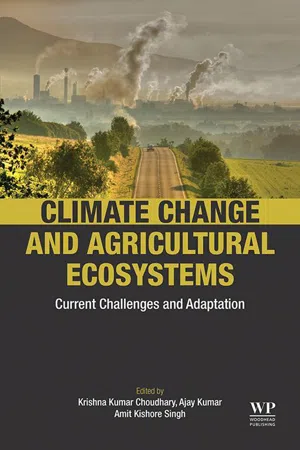
Climate Change and Agricultural Ecosystems
Current Challenges and Adaptation
- 482 pages
- English
- ePUB (mobile friendly)
- Available on iOS & Android
Climate Change and Agricultural Ecosystems
Current Challenges and Adaptation
About this book
Climate Change and Agricultural Ecosystems explains the causative factors of climate change related to agriculture, soil and plants, and discusses the relevant resulting mitigation process.Agricultural ecosystems include factors from the surrounding areas where agriculture experiences direct or indirect interaction with the plants, animals, and microbes present. Changes in climatic conditions influence all the factors of agricultural ecosystems, which can potentially adversely affect their productivity. This book summarizes the different aspects of vulnerability, adaptation, and amelioration of climate change in respect to plants, crops, soil, and microbes for the sustainability of the agricultural sector and, ultimately, food security for the future. It also focuses on the utilization of information technology for the sustainability of the agricultural sector along with the capacity and adaptability of agricultural societies under climate change.Climate Change and Agricultural Ecosystems incorporates both theoretical and practical aspects, and serves as base line information for future research. This book is a valuable resource for those working in environmental sciences, soil sciences, agricultural microbiology, plant pathology, and agronomy.- Covers the role of chemicals fertilizers, environmental deposition, and xenobiotics in climate change- Discusses the impact of climate change on plants, soil, microflora, and agricultural ecosystems- Explores the mitigation of climate change by sustainable methods- Presents the role of computational modelling in climate change mitigation
Frequently asked questions
- Essential is ideal for learners and professionals who enjoy exploring a wide range of subjects. Access the Essential Library with 800,000+ trusted titles and best-sellers across business, personal growth, and the humanities. Includes unlimited reading time and Standard Read Aloud voice.
- Complete: Perfect for advanced learners and researchers needing full, unrestricted access. Unlock 1.4M+ books across hundreds of subjects, including academic and specialized titles. The Complete Plan also includes advanced features like Premium Read Aloud and Research Assistant.
Please note we cannot support devices running on iOS 13 and Android 7 or earlier. Learn more about using the app.
Information
Agriculture in the Era of Climate Change: Consequences and Effects
Abstract
Keywords
1.1 Introduction
1.2 Climate Change and Sustainable Agriculture
Table of contents
- Cover image
- Title page
- Table of Contents
- Copyright
- List of Contributors
- Preface
- Chapter 1. Agriculture in the Era of Climate Change: Consequences and Effects
- Chapter 2. Sustainable Agricultural Practices Using Beneficial Fungi Under Changing Climate Scenario
- Chapter 3. Climate Change and Soil Dynamics: Effects on Soil Microbes and Fertility of Soil
- Chapter 4. Agrochemicals: Harmful and Beneficial Effects of Climate Changing Scenarios
- Chapter 5. Climate Change and Secondary Metabolism in Plants: Resilience to Disruption
- Chapter 6. Impact of Xenobiotics Under a Changing Climate Scenario
- Chapter 7. Impact of Climate Change on Plant–Microbe Interactions under Agroecosystems
- Chapter 8. Medicinal Plants Under Climate Change: Impacts on Pharmaceutical Properties of Plants
- Chapter 9. Air Pollution: Role in Climate Change and Its Impact on Crop Plants
- Chapter 10. Cyanobacteria and Their Role Under Elevated CO2 Conditions
- Chapter 11. Rising Atmospheric Carbon Dioxide and Plant Responses: Current and Future Consequences
- Chapter 12. Climatic Resilient Agriculture for Root, Tuber, and Banana Crops using Plant Growth-Promoting Microbes
- Chapter 13. Understanding Soil Aggregate Dynamics and Its Relation With Land Use and Climate Change
- Chapter 14. Climate Change: A Challenge for Postharvest Management, Food Loss, Food Quality, and Food Security
- Chapter 15. Impact of Climate Change on Soil Carbon Exchange, Ecosystem Dynamics, and Plant–Microbe Interactions
- Chapter 16. Bioinformatics as a Tool to Counter Climate Change: Challenges and Prospects
- Chapter 17. Developing Adaptive Capability of Agricultural Societies in the Context of Climate Change
- Index